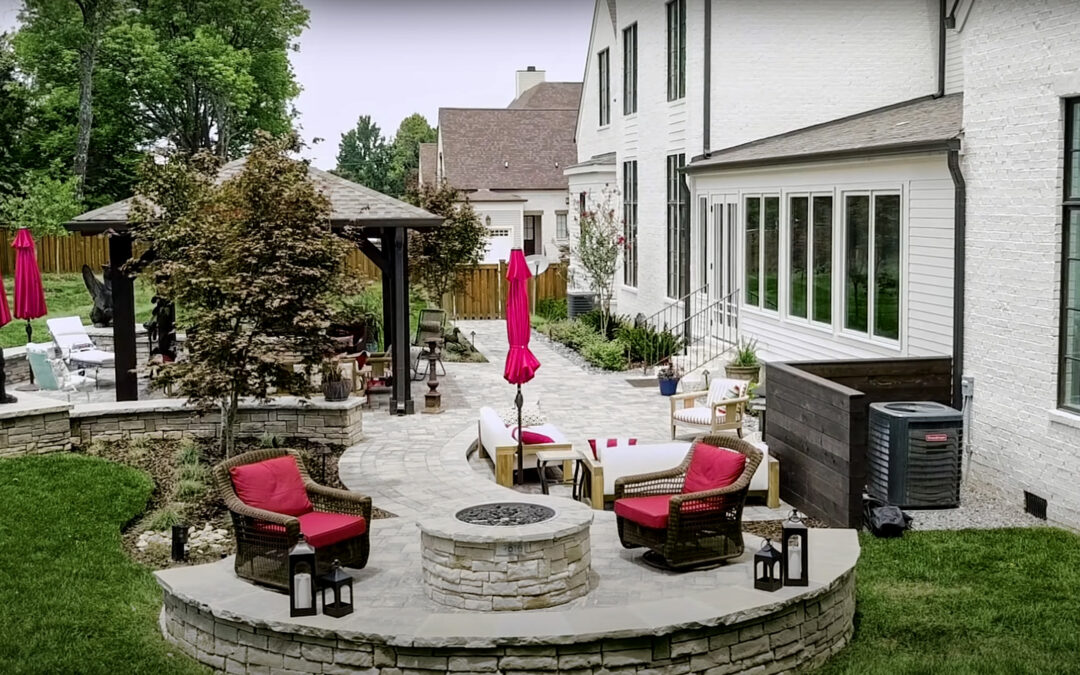
by Katelyn Latture Duvall | Mar 29, 2024
While it might be warming up outside, spring has that tricky habit of still being cold at night. But, that doesn’t mean you have to go inside when the sun goes down and the temperature drops.
Fire pits and outdoor fireplaces are some of the best additions to extend your enjoyment of outdoors spaces. Plus, they bring the comfort of your indoor living spaces outside, and add more visual interest to green spaces.
Here are some design ideas to bring the coziness of a fire outside without compromising on style:
Portable Fire Pits
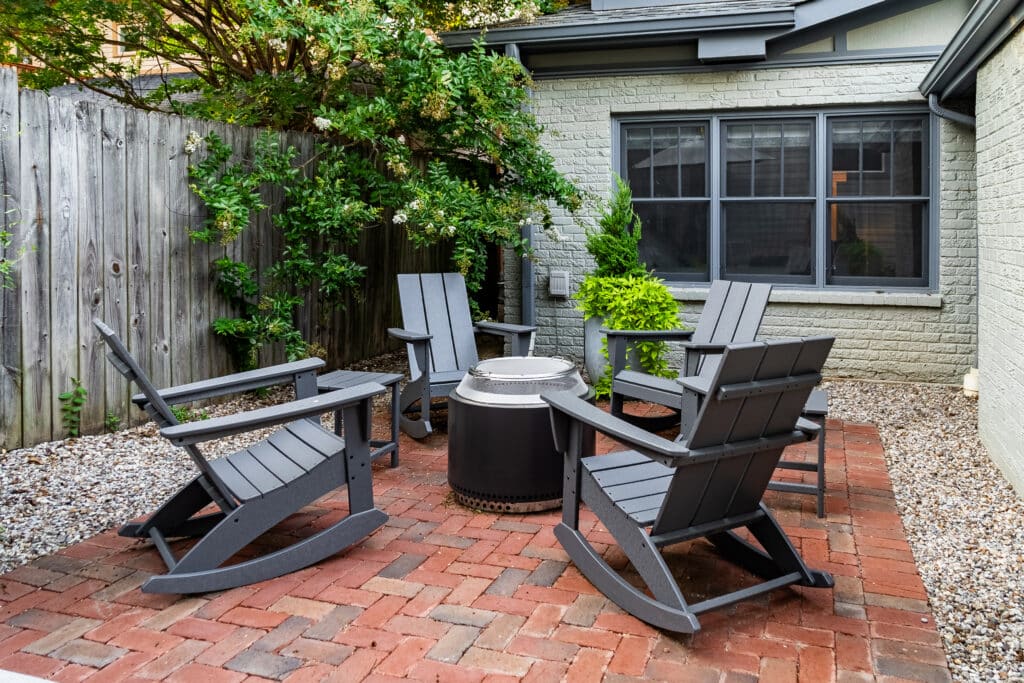

Let’s start with ideas for small spaces. Portable fire pits (also sometimes called outdoor wood stoves) are great for patios and yards of all sizes, but these metal cylinders are optimal for small outdoor spaces. They often come in sizes smaller than a permanent fire pit, and – major bonus – they can be moved!
This is an excellent feature, especially if your patio serves multiple purposes. Portable fire pits can easily be moved into a shed or garage, if you need to make space for other activities or want to store it for winter. Depending on what brand and size you purchase, these can also be taken on trips – think camping, lakeside or even on the beach.
Propane Fire Pits & Tables

If you like the small footprint and movability of a portable fire pit, but don’t like the added task of keeping firewood, a propane fire pit is a great alternative. These come in a wide variety of sizes and styles, including fire pits, tables, bowls and more. You can find them in metal, glass and stone, and the features covering the burners can be anything from charcoal (pictured above) to glass beads, faux wood and nearly whatever else you can think of.
So long as they aren’t hooked up to a built-in/permanent gas line, these can also be moved wherever you want. Plus, since they’re gas burning, you don’t have to worry about cleaning out ash or watching for flying embers.
Permanent Fire Pits
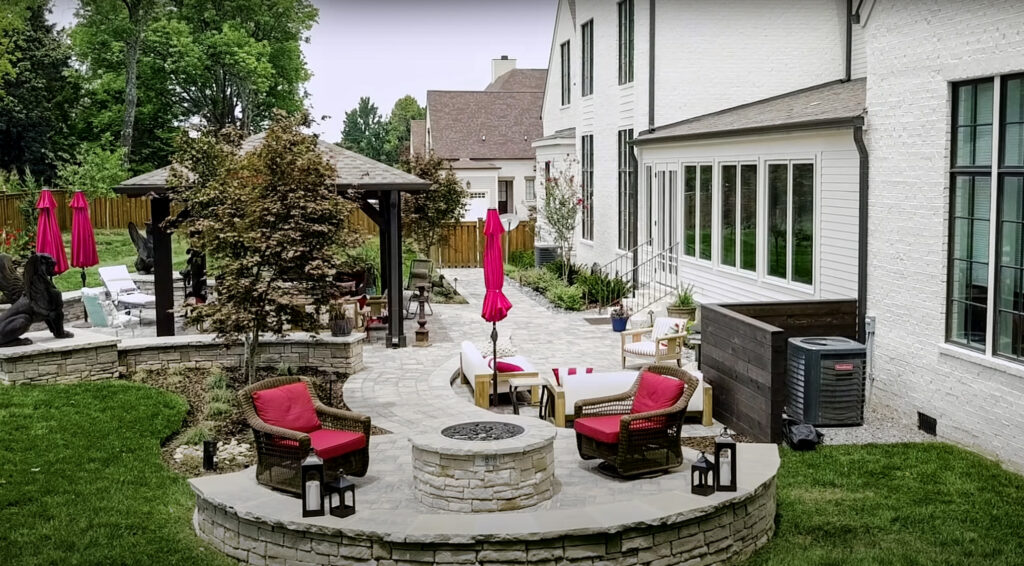
If you have more space, or are looking for a more permanent feature, a stone or brick fire pit could be the way to go. These offer plenty of design options from the material used to the shape they’re laid in. You can use the same or similar brick, stone or concrete used in other parts of your home design (think chimneys, patios, etc.). This ties together your outdoor living space with your home’s other exteriors and/or interior design.
You also don’t need a patio for permanent fire pits. Many people have leveled out spaces in their yards to curate a space that feels more like sitting around the campfire. This can help cut down on costs, keep the fire further from your house, and create a more secluded feel. Grass, wooded areas (but not too close to those trees), and outdoor chairs or logs to sit on create a cozy, more outdoorsy space.

To modernize the fire pit, you can add it to a patio and even add coordinating bench seating, like a previous Gardens of Babylon residential project pictured above. Not only does this save space, it also ensures a beautiful and cohesive design. Plus, it keeps you from having to worry about other outdoor furniture wearing out from exposure to the elements.
Fireplaces
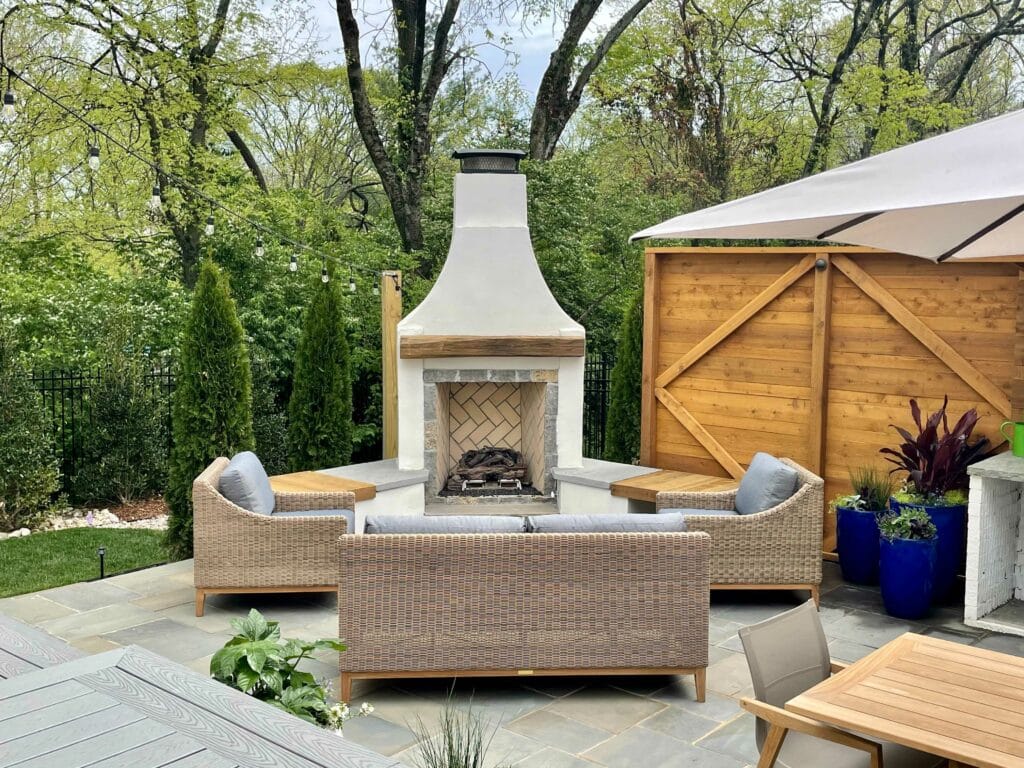
If you’re looking for a real showstopper, an outdoor fireplace can’t be beat. These beautiful, permanent features make for a cohesive and seamless transition from your indoor living space to your outdoor one.
Like other outdoor fire features, these can be constructed from brick, stone, concrete, etc., and come in both wood-burning and gas-burning varieties. However, these also have the added bonus of extra design flexibility. (You could even build an outdoor fireplace plus brick oven – great for homemade pizzas!) Outdoor fireplaces, since they’re larger than other options, have more room for brick treatments like German schmear, stucco and more. They can also pull in various design pieces from a patio and house’s exterior to bring together different elements. You can use tiles or bricks from patio flooring as pops of design in the fireplace structure – much like the tile pictured above peeks out from the edges of the firebox.
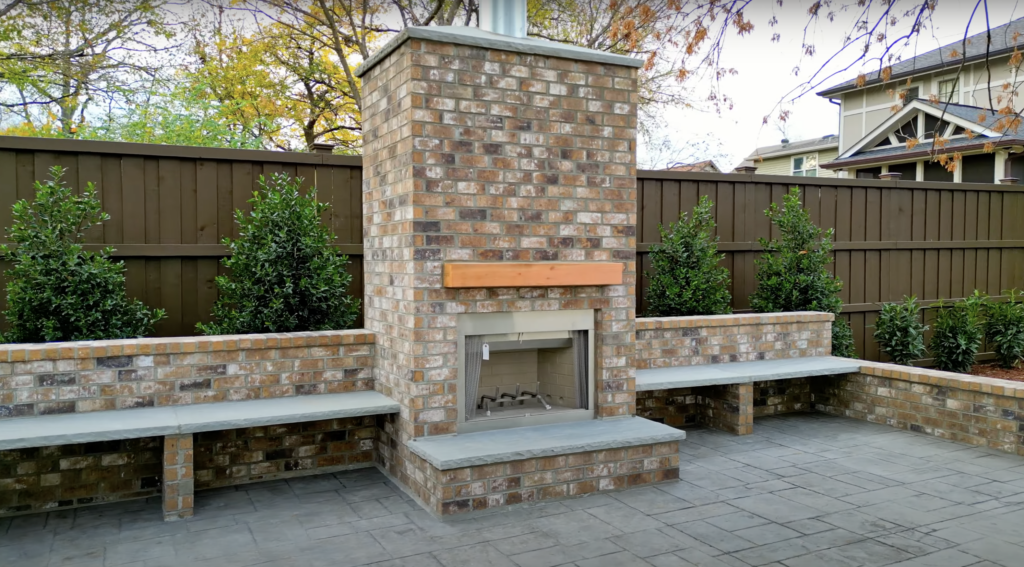
Outdoor fireplaces are the real stars of the show and can be used for a variety of design purposes. You can use them to separate one outdoor living space from another. They can corner off a patio, like the one pictured above. Outdoor fireplaces can also function as the finishing touch on a backyard – sitting at the pinnacle of a patio.
However you decide to bring the warmth of the indoors outside, no outdoor living space is complete without a fire feature. Enjoy your outdoor spaces sooner and longer this year by adding one of these essential, functional elements to your patio or backyard.
Do you love one of the designs featured in this post? (All of these are residential projects crafted by our design team at Gardens of Babylon.) If you’re looking for something similar, or need some inspiration or design help, contact us! We’re all about making outdoor spaces functional, beautiful and enjoyable. Come see us at the garden center, or schedule an appointment with one of our designers.
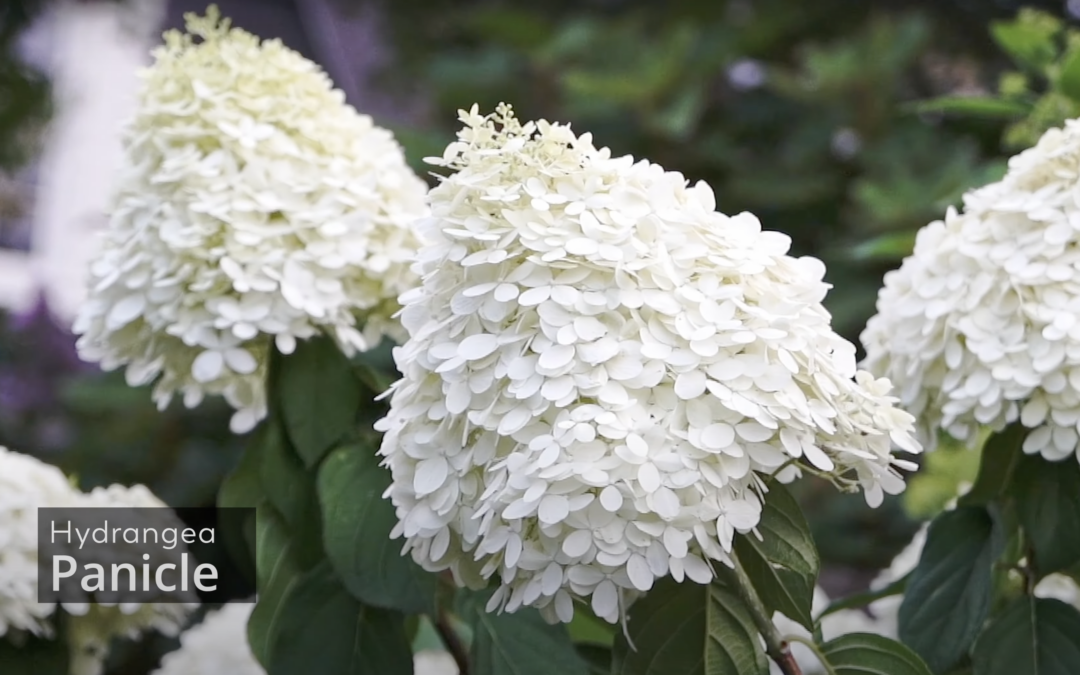
by Katelyn Latture Duvall | Mar 26, 2024
Spring is officially here (or at least it is if you’re reading this as it’s published), and you’re likely itching to get in the dirt and make your outdoor spaces greener.
But, you likely also run into the same problems that most of us do. What do I actually plant? And, how do I know if it can be planted this time of year?
The Nashville area is in the 7b zone of the USDA’s plant hardiness zone map. Hardiness zones are based on an area’s average lowest extreme temperature. So, in the case of the Nashville area, that would be 5-10 degrees Fahrenheit. Be sure to check the labels on plants, as they normally indicate the zone for which they are best adapted.
Now that you know more about hardiness levels, it’s time to look for some inspiration! Here are 10 shrubs and trees that will add interest to your yard in any season:
Hydrangea
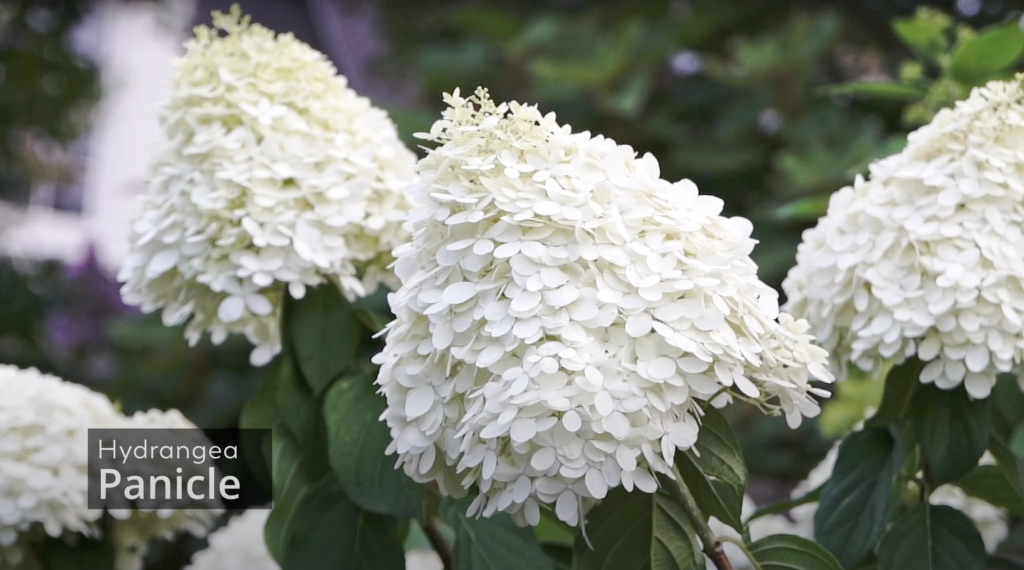

This shrub is a favorite, especially in the south, because of the beautiful, large blooms it produces. There are several varieties of hydrangeas, but the oak leaf hydrangea is native to Tennessee. It has cone-shaped blooms, as well as large leaves shaped similarly to those of an oak tree (hence the name). Hydrangeas can be prone to root rot, so make sure you’re checking soil moisture levels before watering.
Looking for more information on the beloved hydrangea? Check out our post for the full guide to caring for these southern beauties!
Boxwood
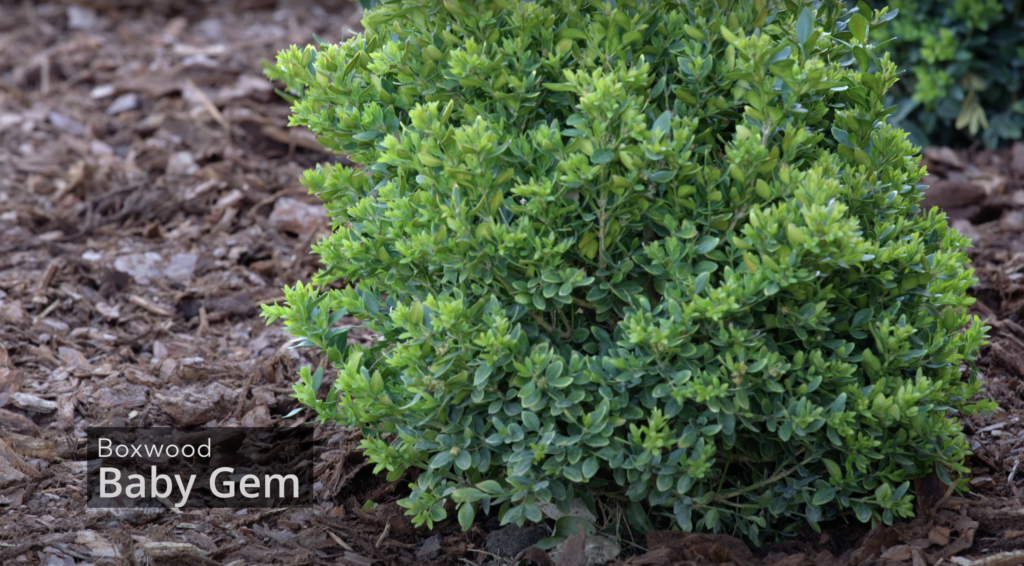
When you think of bushes in landscaping, the boxwood is probably what first comes to mind. While this classic shrub isn’t native to North America, it’s a classic in landscaping worldwide. That’s thanks to the boxwood’s many varieties being easy to grow, adaptable to different conditions, and its overall hardiness.
Holly
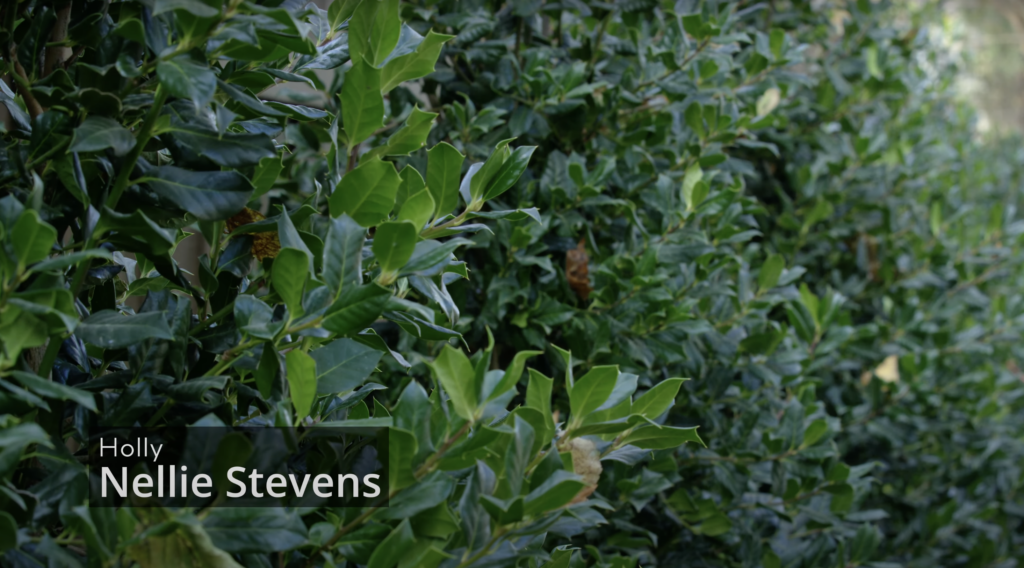
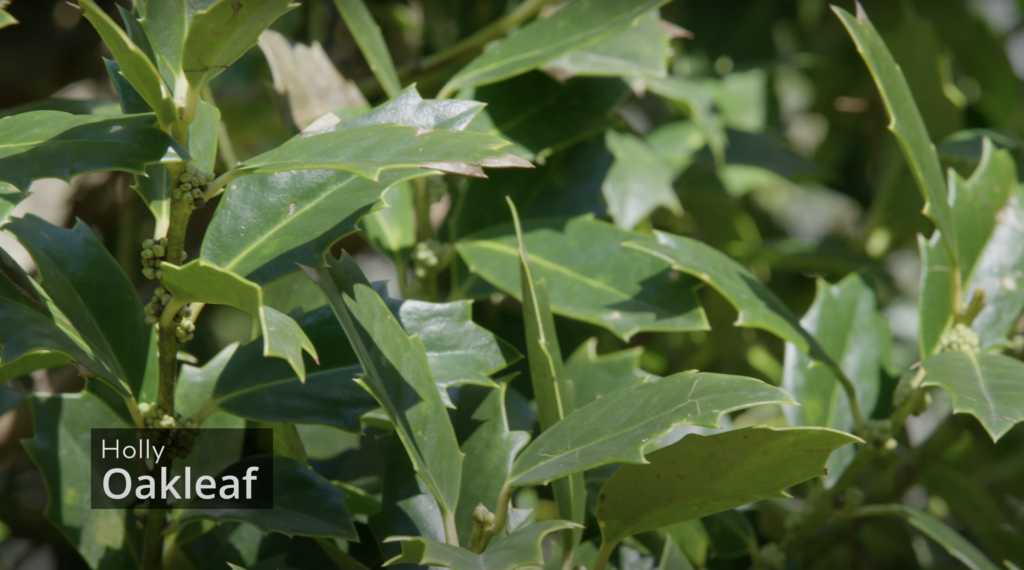
Holly comes in both shrub and tree forms with their glossy green leaves. They also have blooms that pollinators love, and then there’s the classic holly berry that’s reminiscent of Christmas time. They also come in both evergreen and deciduous varieties. So, if you’re looking for something to keep your outdoor spaces green year round, make sure you’re planting an evergreen variety. (Inkberry holly can be a great native alternative to boxwoods.)
American Beautyberry

As the name suggests, this shrub is native to America, and is also native to Tennessee. It does produce small flowers in the spring, but the crown jewel of this shrub is the bright purple berry clusters it yields in the fall. If you’re looking to welcome more wildlife, like birds and deer, the fruits of this shrub should do the trick. The American beautyberry tends to grow wide, so it can also be a great option if you’re looking to fill more space with fewer plants.
Crape Myrtle

Crape myrtles come in shrub and tree varieties, but you’re likely most familiar with the trees. These are popular plants in the southeast, and you’ve likely seen them in neighboring yards or even along well-kempt highways and interstates. While the varieties that grow best in this area aren’t evergreen, crape myrtles do provide interest to outdoor spaces year round. They produce leaves in the spring, and they have beautiful exfoliating bark – much like a birch tree – that is exposed in the late fall and winter months. They flower in the summer with blooms that can be white, pink, red or even deep purple.
Rhododendron
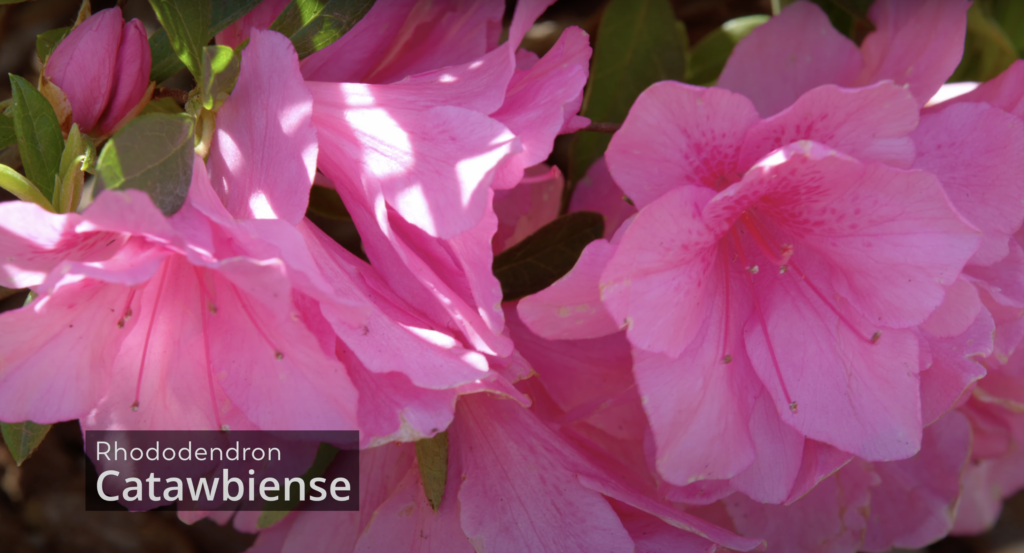
If you’ve been to the Great Smoky Mountains, then you’ll probably recognize this plant. It comes in shrub and tree varieties, most of which are evergreen. They do best away from direct afternoon sun and thrive in partly shaded areas. These shrubs and trees have green leaves and normally flower in the spring or early summer. (Even if you’re unfamiliar with rhododendron in general, you’re likely familiar with another popular shrub in the same genus – azaleas!)
Eastern Redbud
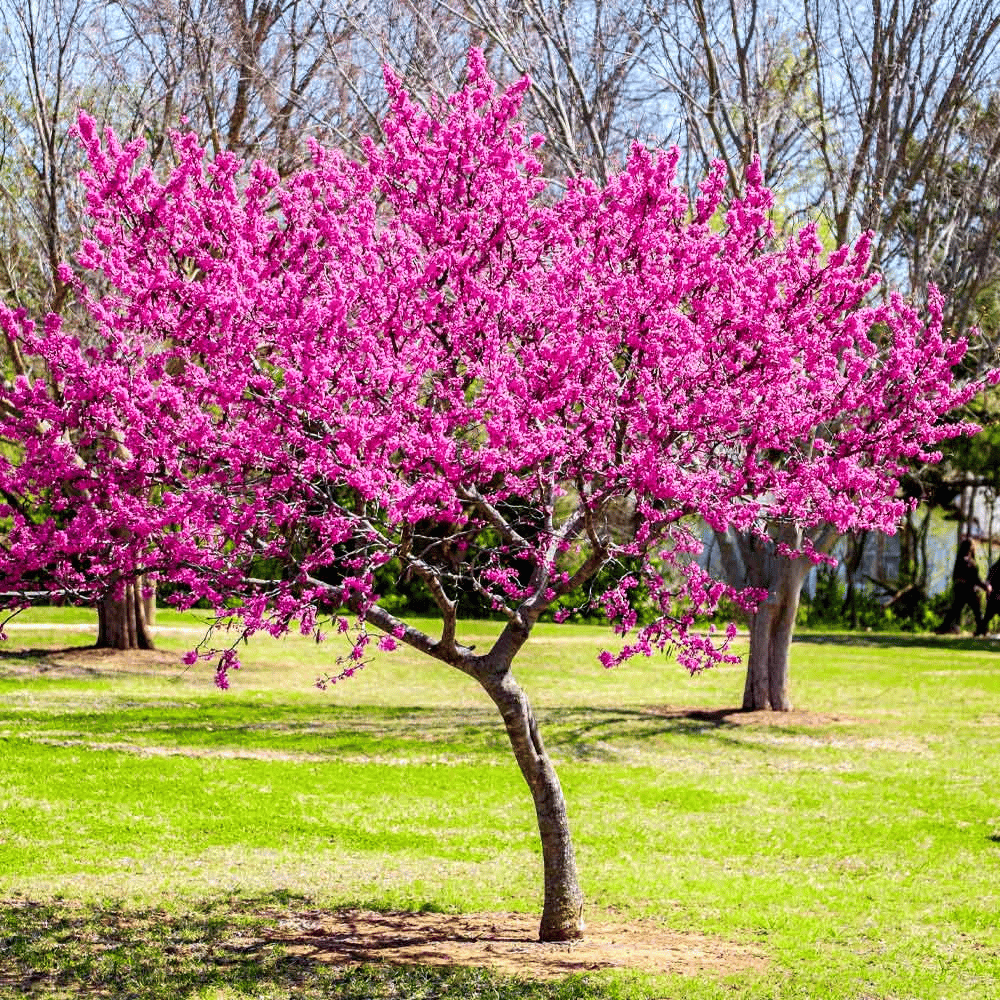
This one is a personal favorite of mine, especially since it’s one of the first signs of spring. While the eastern redbud is a tree, it is a smaller one that can pass for a large shrub depending on how you shape it. This plant is known and loved for its deep pink, springtime flowers, as well as its irregular and wide branch patterns. This eastern North American native provides nectar to insects in the spring, and is often used by birds for nesting and shelter once leaves take over the branches. It’s a wonderful option to fill wide spaces and provide a bright pop of color in the spring.
Cherry Laurel

photo from North Carolina State Extension
This shrub is one of the fastest growing, and it’s also likely another shrub you’ve seen around. This evergreen bush produces fragrant, white flowers in the spring and has large leaves year round. The cherry laurel also yields fruit that resembles a cherry. It is important to note that ingesting any part of this plant is poisonous to both humans and animals. If you have small children or curious pets, this shrub is likely not a good choice for your landscaping.
Juniper
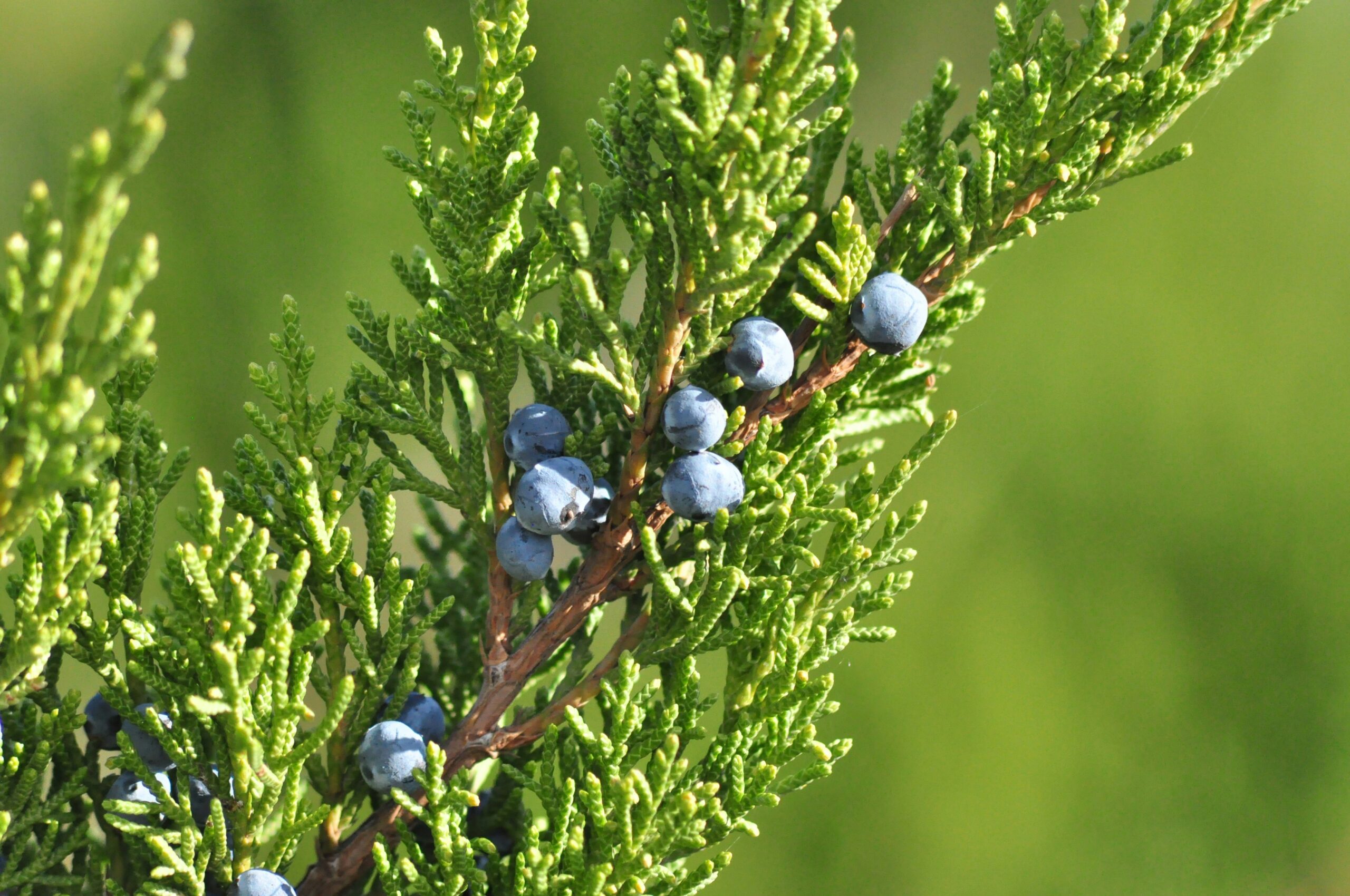
Whether or not you know it, you probably see junipers anytime you leave your house. These evergreen shrubs and trees grow in most of the United States. The juniper tends to be low maintenance and provides color and privacy to your yard all year long. They fit well in tight spaces, help prevent soil erosion, and even provide for wildlife with their small berries.
Abelia
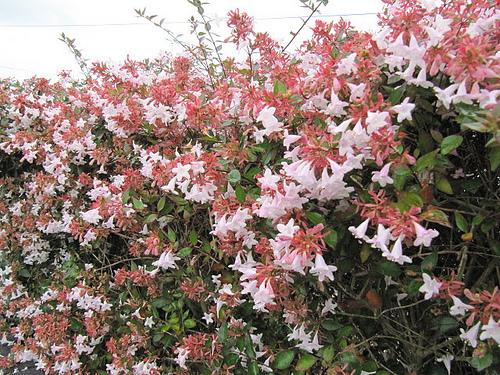
photo from North Carolina State Extension
If you’re searching for another flowering shrub, abelia might be the right choice for you. Part of the honeysuckle family, this shrub produces small but plentiful blooms with a sweet smell. While not native to North America, these flowering shrubs are still a favorite among southern gardeners. The abelia is often dense and can sometimes be used as hedging or screening, unlike many flowering shrubs. They also tend to need a little more care when it comes to watering and pruning to ensure optimal growth and flowering.
Now that you’ve made it to the bottom of this list, you have plenty of options for shrubs (and some trees) to enhance your outdoor spaces this year. Happy planting!
Need more inspiration, or even some design help? We’re all about making outdoor spaces usable, beautiful and enjoyable. Come see us at the garden center to get your questions answered, or schedule an appointment with one of our designers!
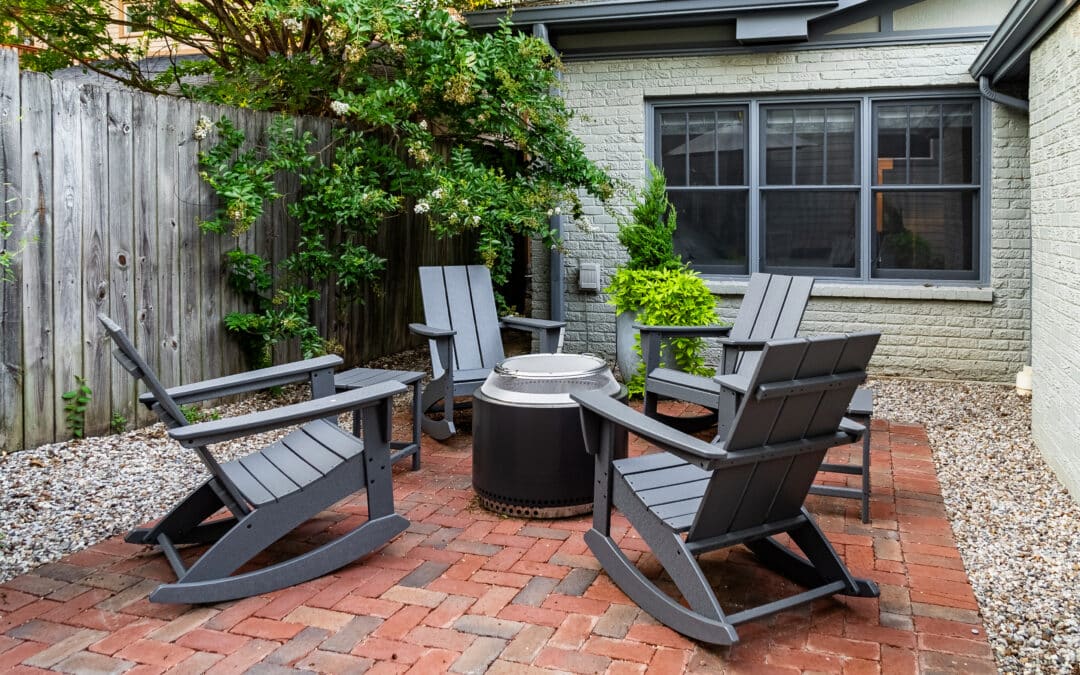
by Katelyn Latture Duvall | Feb 26, 2024
Prefer to let us bring your vision to life for you? Our designers are the best at taking small or large outdoor areas and creating beautiful spaces with them. Book here!
It can be difficult to figure out how to bring the natural beauty and benefits of plants to your home’s exterior when you feel like you don’t have the space. Creating an outdoor sanctuary in a small space demands imagination, strategic design, and a sharp eye for beauty. Whether that outdoor space you have is large or small, there are a variety of ways to elevate that area and create a personal outdoor sanctuary. Here are three things you can use to spice up your outdoor spaces, big and small:
1. Let’s start with our tried and true… potted plants!
Whether you have a large yard or a small apartment balcony, potted plants are your best friend. You can add pops of color with flowers, different decorative grasses, cascading or vining plants, and more. There’s really no limit on what you can do with a pot or multiple pots.

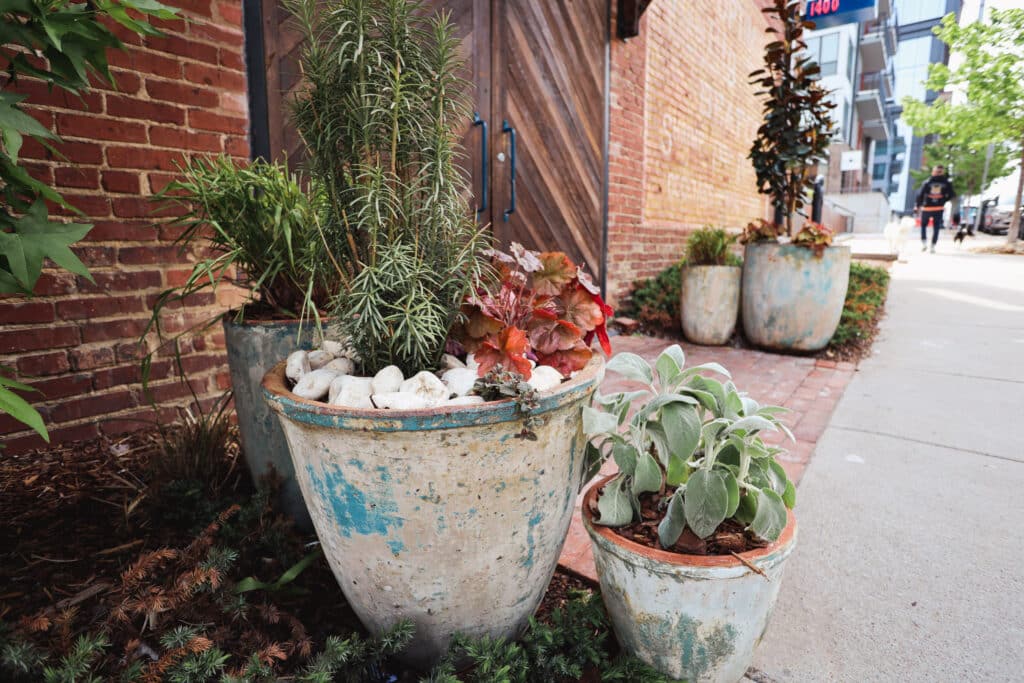
Even something as simple as a couple four-inch pots filled with herbs or leafy vegetables for cooking, placed on an outdoor table, can liven up your small balcony. Do you already have some indoor plants that would love the extra humidity and sunshine this summer? You can bring them outdoors for the season to promote extra growth while also saving some money to decorate your outdoor living space.
If you have more space – like on a larger patio or even front door steps and walkways – you can pot small trees and place them around your space to add depth and drama. If you pick a hardier variety, you may not have to worry about them as much as other plants in the fickle Tennessee weather.
Adding pots of different sizes and colors, filled with varieties of plants, can make your limited outdoor space even more interesting. If you don’t have the space for larger pots, you could instead use plant stands to save space while still adding height and intrigue. 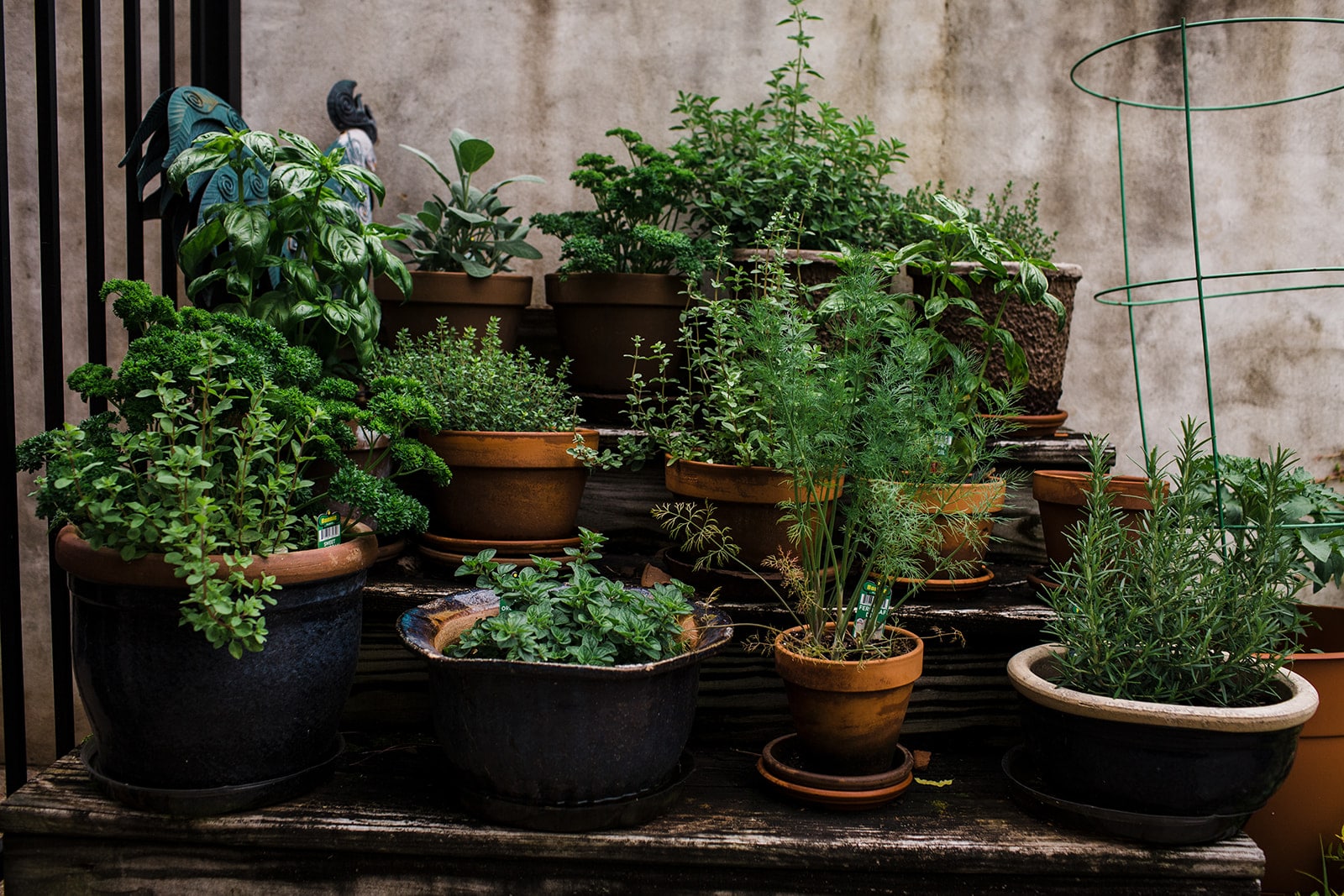
And, later in the year, when we transition to fall, you can replace spring and summer varieties with mums, pumpkins and other autumnal favorites.
Some of our potted plant suggestions: When it comes to potted trees, a dwarf conifer is where it’s at. You can think of them as the little black dress of patio plants because they’re classic, go with everything, and look great year round. Rhododendrons can also be a great choice as they’re also evergreens, and they produce beautiful blooms in the summer.
No space for a tree? We have even more suggestions for that! When it comes to low maintenance flowers, you really can’t go wrong with pansies. They’re sturdy little things that can withstand a light frost, which comes in handy when you live with the unpredictability of a middle TN spring. Coral bells make a great leafy addition to any pot, as they come in different colors and handle temperature fluctuations well. There are also several cascading varieties, like ivies and petunias, that add even more depth to your pots.

2. Another southern favorite… hanging baskets.
Whether you’re new to Nashville or have lived in the south all your life, you’ll quickly notice the love of hanging plants here. Everything from ferns to flowers occupy these aerial beauties.
When you don’t have ground space for plants, why not look up? Hanging baskets are a great way to save space, and you don’t have to worry about the drainage of a pot. They also add drama to your outdoor spaces (but hopefully without the gossip of your too-chatty neighbor 😉).
Some of our hanging basket recommendations: There’s nothing quite as classic or simple as a fern. They’re a staple of southern homes in the late spring and throughout summer, and they’re great if your balcony or porch doesn’t get much sunlight. However, if you’re looking for something with more color, you can mix and match just like with potted plants. Some of our favorites include sweet potato vine, geraniums, impatiens, and snapdragons.
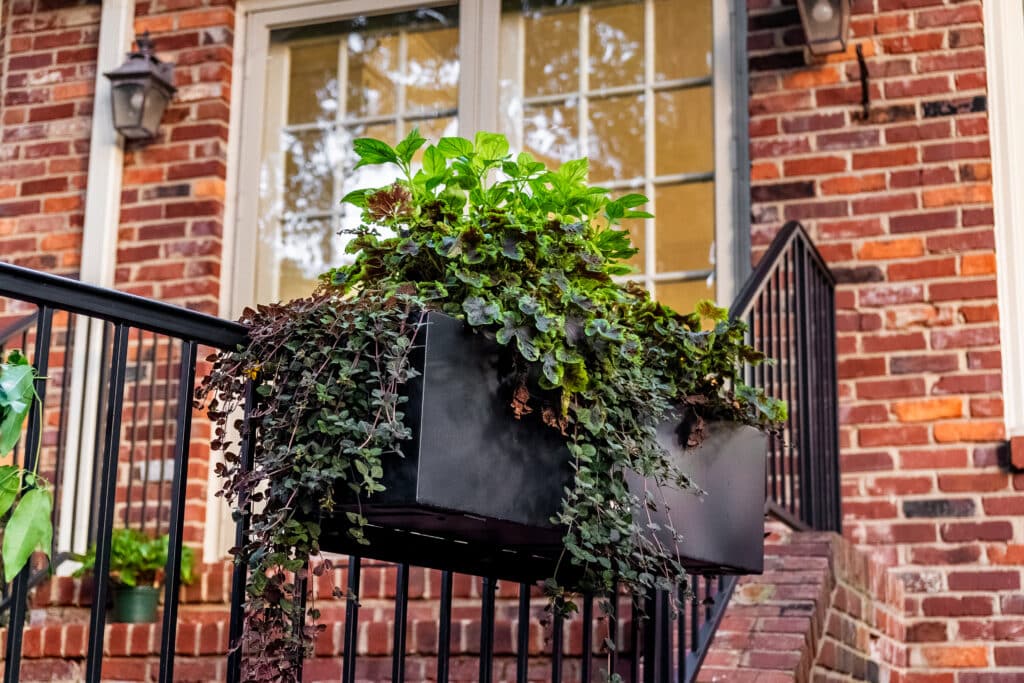
3. No patio or balcony roofing? Say hello to balcony boxes and window boxes.
Both are great options if you have absolutely no outdoor green space. You can drill them onto your balcony or porch railing or right under your window. (If you rent or lease your property, check with your landlord before drilling into spots like these.) There are also drill-free options with hooks that wrap over and around your railing. You’ll just want to keep an eye on them on extra windy days. You can even build your own box if you want a more unique look, or if you want a fun afternoon project!
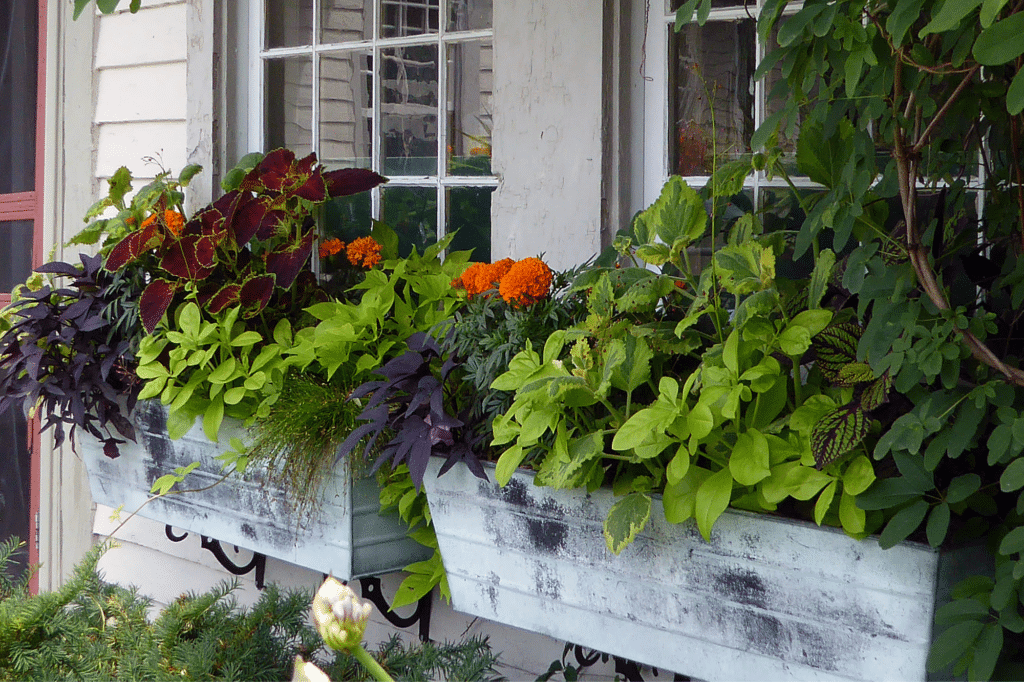
Some of our balcony/window box suggestions: If you want something both beautiful and practical, you can use your balcony box as a small herb garden – think cilantro for your homemade salsa or as a garnish for your taco Tuesday. Not to mention some fresh mint for the mojitos that would pair so well with both your salsa and tacos! Not feeling the herb love but would love to utilize other edible plants? Check out our edible plants blog post here. You can also use our other suggestions from potted plants and hanging baskets when it comes to these boxes (except trees, of course).
Having limited space outside doesn’t mean you can’t have beautiful outdoor spaces. It just means you might have to be more creative with how you curate those spaces, and we’re all about getting creative here at Gardens of Babylon! So be sure to come see us at the garden center to get the perfect plants for your new outdoor space. Or schedule with one of our designers to have us bring your vision to life!
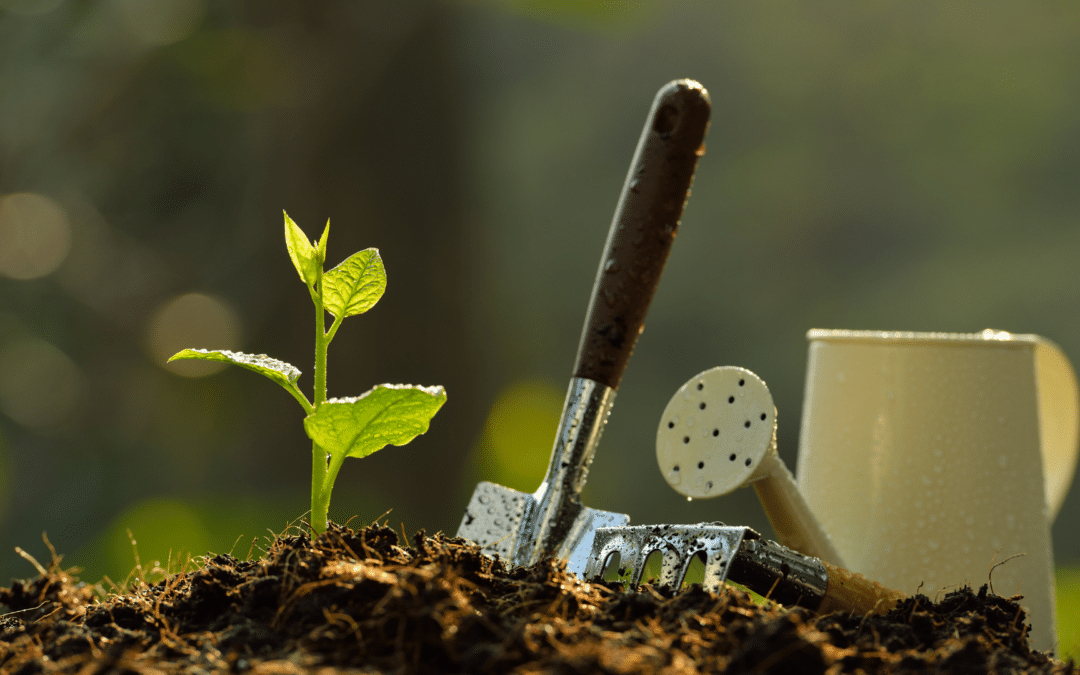
by Katelyn Latture Duvall | Jan 10, 2024
Gardening isn’t just for the summer months. The seasoned gardener knows there are things they can be doing each month of the year to make gardening more fruitful and easier each year.
January & February

Now is a great time to start planning your gardens for the spring and summer! If you’re completely new to gardening, planning early can be one of the best things you can do for yourself. It helps dispel potential stressors when spring rolls around, and it gives you time to educate yourself on how to start, care for and maintain your garden.
Winter is also optimal for redefining garden bed edges, whether that means sprucing up existing ones with new materials or plotting out new areas. January and February are also good months to freshen up the mulch covering your garden beds. You can dispose of the wood shavings or bark, rake off any debris, and then replace it with a fresh layer of compost or mulch. This will keep nourishing your beds until you’re ready to plant in the spring. For more details on how to boost spring results by preparing in the winter, check out this blog post.
When it comes to trees and shrubs, you can do some light pruning during the cold months while plants are dormant. Be sure to not prune too much, as you don’t want to invite in any pests or diseases.
Depending on what you plan to grow this spring, February can be ideal for starting seeds indoors. Generally the back of your seeds packet will tell you the best times for starting seeds indoors and when to move the seedling outdoors and into your garden.
March

While you can start some seeds indoors in February, most seeds are best started in March! It’s often still too cold outside for most seeds to survive, as the final hard frost of the year is after spring has officially started. However, there are some cold-hardy plants whose seeds you can start outside in mid-to-late March, including arugula, beets, broccoli, fava beans, kale and more.

Depending on where you live in the mid-state and how spring is faring this year, there are even some cool-weather plants you can welcome to your garden beds. Think hardy veggies, like lettuce, radishes and carrots. As for decorative plants, March can be prime time for planting annuals that can handle cold snaps, like pansies and snapdragons.
April

After the final hard frost of the year, which generally occurs the first week of April, it’s time to start planting! Whether you’re starting your own seeds indoors (be sure to check your seed package for best times to start based on where you live) or are transplanting young fruit and vegetable plants from a garden center, April is probably the month to start. If you’re starting seeds outdoors, late April is often optimal as it’s finally warm enough. Plus, if timed correctly, you can plant new seeds and transplants in intervals – much like the Amish do – to ensure you’re getting fresh produce all summer long.
April in middle TN can be unpredictable, so be sure to check the hardiness levels of your plants. You might need to cover your garden at night should temperatures drop too low.
Now is the time to plant your summer bulbs, like dahlias, as the soil is finally warming up. You can also start pruning flowering shrubs and climbing roses after they’ve bloomed to help reshape them and trim any straggling branches.
May & June

You can continue planting new seeds and seedlings for most summer plants (okra, squash, zucchini, etc.) throughout the summer. If you haven’t started yet, don’t fret! You can keep planting through May, June and most of July.
As the summer ramps up, keep an eye on the moisture levels in your garden. Heat in middle TN can be deceptive with the humidity. Check your soil daily to make sure you aren’t under- or over-watering your garden.
May is optimal for replacing your spring annuals with warm-weather annuals as middle TN starts heating up. If you have tropical bulbs you’ve been waiting to sow, May is also the month to start planting those. These heat-tolerant plants will thrive in June and July.
July

Your summer garden is likely producing most of its yield this month and into August. So, the best things you can do to care for it would be watering it regularly, harvesting produce as it’s ready, pulling weeds as they pop up, removing dead plants as they yield their final fruit, and picking up any debris that might get in the way of your plants. These same rules go for your flowering plants – remove any faded blooms, do some light trimming as necessary, and clean up debris from your yard and plant beds.
Toward the end of July and into August as you begin to clear out your garden of summer plants, you can also begin planting seedlings and transplants for fall produce, like Brussels sprouts, carrots and other root vegetables.
August

If you’re not quite ready to say goodbye to your produce for the year, mid-to-late summer is a great time to plant seeds for produce that is cold-weather hardy, especially many root vegetables. These crops include broccoli, cabbages, carrots, garlic, radishes, spinach, turnips and more. For more tips on how to transplant and care for these, check out our post on preparing your garden for fall.
Continue basic maintenance for your vegetable gardens and landscaping alike, as you remove dead plants and flowers and care for growing ones.
September & October

It’s time to gather up your final harvests! Whether or not you planted a fall garden, once your plants have finished producing fruits and veggies, it’s time to pull up those that are dead or dying. Now is also a great time to trim foliage and clean up other debris in your garden beds. If you’re anything like me, you might also have gotten tired of pulling weeds in the summer heat. So, now that weeds are drying up and the temperature is cooling down, it is the perfect time to pull those pesky garden invaders.
For more soil maintenance, you can also top off your garden beds with compost, organic fertilizer, mulch, or shredded leaves. If you don’t want your garden to lay bare or be taken over by grass until next summer, you can take a little tip from my dad who’s farmed and gardened his entire life. Till up the soil and plant clover or another cover crop. It will bloom into lovely hues of green, crimson and purple and also attract pollinators. Other cover crops include alfalfa, buckwheat, annual rye and mustard greens. Then, when you’re ready to plant your garden next summer, you can use a garden tiller to pull the cover crop and rotate it back into the soil for nourishment.
If you have perennials or annuals, September and October are great months to be pruning and deadheading these plants. You can gather up the final blooms to make bouquets for yourself or as gifts for friends and family as a final homage to summer.
While harvesting might be over, fall in Tennessee is the best season for plantings. Don’t believe me? Read these five reasons why fall is the best season for planting. Due to middle TN having a temperate climate, plants in this area don’t die in the winter – they go dormant! This, paired with the cooler temperatures and higher moisture of fall, means that your new plants can establish a healthy environment before going dormant for the winter.
November

All the leaves have fallen by now, so this is a good time to rake up and mulch leaves. After mulching leaves, you can spread them across your garden beds to help snuff out weeds while also nourishing the soil for next spring.
Depending on what you planted in your fall garden, you might still be harvesting in November. Collect the final harvests and clean up what you can. If you didn’t clean up all the weeds and debris last month, now is a great time to do so before the holidays are in full swing and the temperatures drop. You can also pull up any other diseased or dead plants in your yard before the ground gets too hard.
Looking to add color to your yard next spring? November can be just right for planting perennial bulbs, like narcissus, to ensure they pop up in the spring.
December

If you still haven’t cleaned up your garden beds, this month is the month to do it. Hard frosts have likely killed off anything that was left in your fruit and vegetable gardens, so be sure to clean out dead plants, weeds and debris – that way your garden will be ready to go in the new year. Happy gardening!
Have more questions, or need help planning out your garden and maintenance for the year? Reach out to our team, or visit our garden center in Nashville!
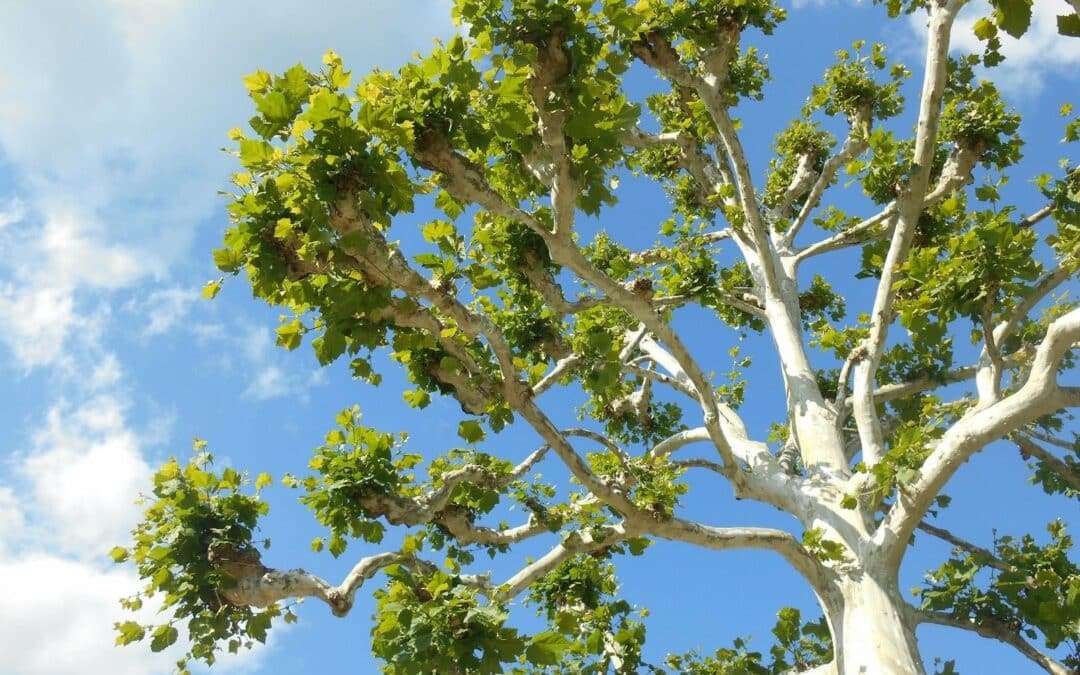
by Katelyn Latture Duvall | Nov 15, 2023
The leaves have fallen, and most plants are going dormant for the year. We’re now in the thick of fall, winter is fast approaching, and you may be thinking landscaping is done for the season. But, you don’t have to wait until spring to spruce up your flora and fauna!
Here are seven trees to plant this fall:

Buckeye
The buckeye tree is a great option for those who love a flowering plant. The buckeye flowers in early spring and produces the well known “buckeye” nut, termed so because it resembles a deer’s eye. However, don’t be fooled by these nuts that also resemble the tasty peanut butter-chocolate dessert! Buckeye nuts are not edible. However, they can be used to plant more buckeye trees. If you do wish to plant more buckeyes from your own seeds, you can expect to collect the nuts once they’ve naturally fallen from your tree, typically in September and October.
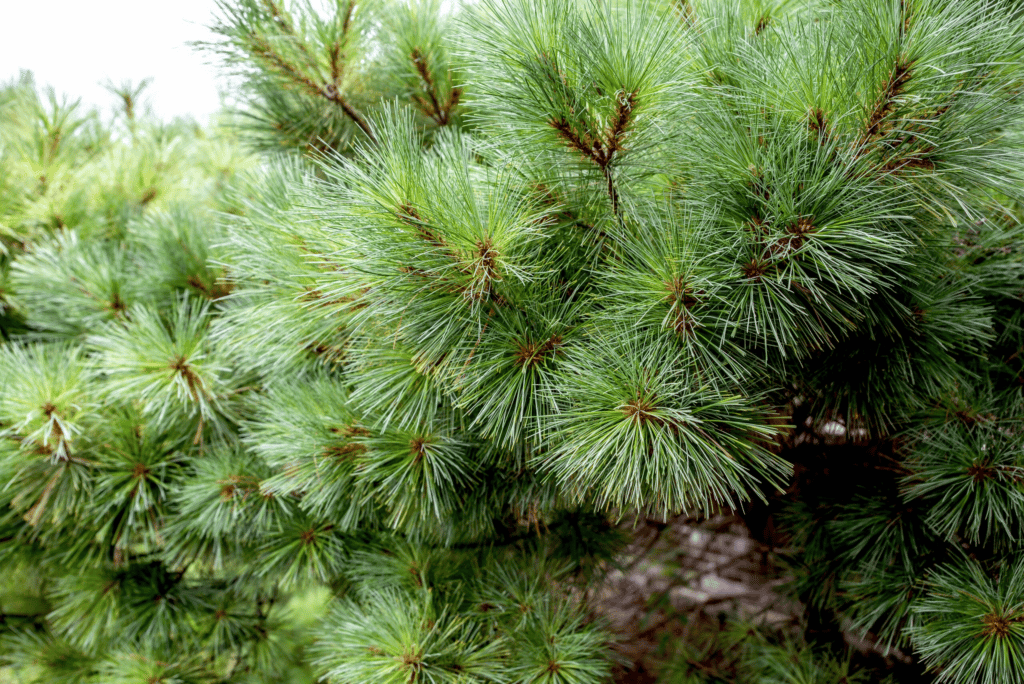 Eastern White Pine
Eastern White Pine
If you’re looking for a Christmas tree you can plant in your yard after the holidays, this evergreen might be the one for you. This conifer is one of, if not the largest pine in the United States. At maturity, they can be over 75 feet tall and 2-4 feet wide, so this is a tree for which you want to ensure you have enough space. Make sure the root ball is intact, so this beauty can be planted in your yard (weather permitting) once the Christmas décor has been taken down.
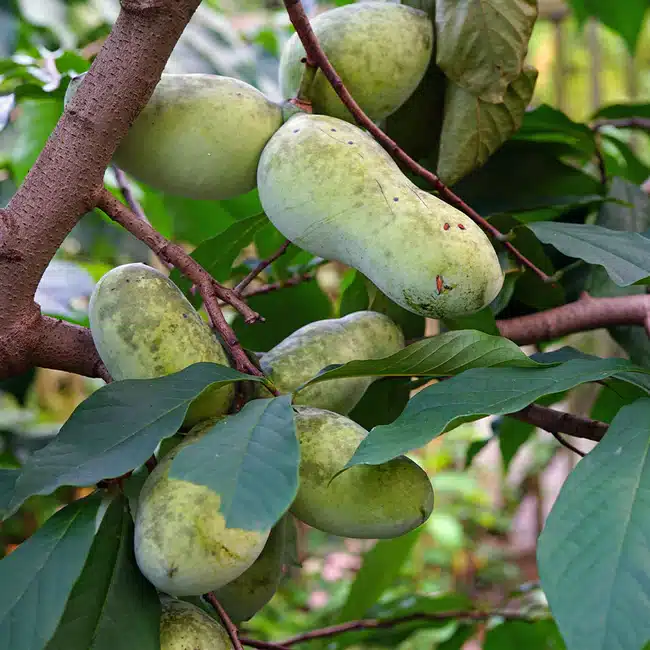
Pawpaw
The pawpaw is part of a mainly-tropical family of plants, so it may come as a surprise to know it is native to the eastern United States! It’s the largest edible fruit native to the U.S., so you’re in for a treat if you own one of these fruit-bearing trees. Pawpaws are not large trees and range from 15 to 30 feet in height, while their trunks average 6-12 inches in width. These trees produce flowers in the early spring before giving way to green leaves, yield ripened fruit (tasting similar to other tropical fruits like mangos and papayas) in late summer through September and October, and have leaves that turn yellow in the fall. Note that more than one pawpaw plant is necessary to produce fruit through cross-pollination.
Persimmon
While most flowering trees shine in spring and summer, this native Tennessean is a true beauty this time of year. The American persimmon tree has leaves that turn a vibrant red-orange in the fall, and it produces a beautiful orange fruit (Go Vols, am I right?) in the fall and winter. Like the pawpaw, these trees need to be planted in pairs, as a male tree and a female tree are necessary in order to yield fruit. Patience is also key with this tree, as it may take several years for them to produce fruit once planted. But, who knows? Perhaps you’ll get lucky with some that produce their little, orange fruit sooner rather than later!
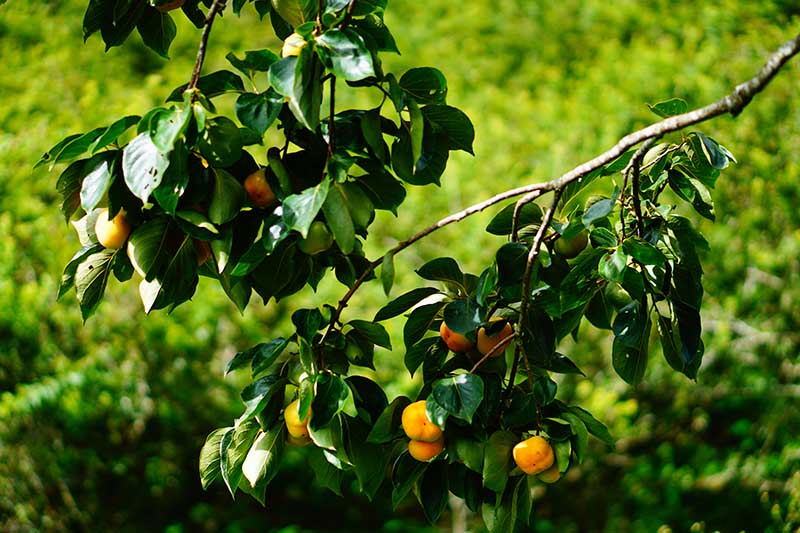

Redbud
If you’re looking for a beautiful pop of color without the size of some other trees, the redbud might be the tree for your landscape. It’s a native tree with rosy pink flowers that appear in April before giving way to reddish-purple leaves that turn green in the summer and then yellow in the autumn. The flowers are also replaced by legumes that ripen in October and can remain on the tree through winter. The seeds from these legumes are typically spread by wind and birds. Redbud trees typically grow 20 feet in height and can have a spread of branches as wide as they are tall, so they can be a great addition to nearly any yard.
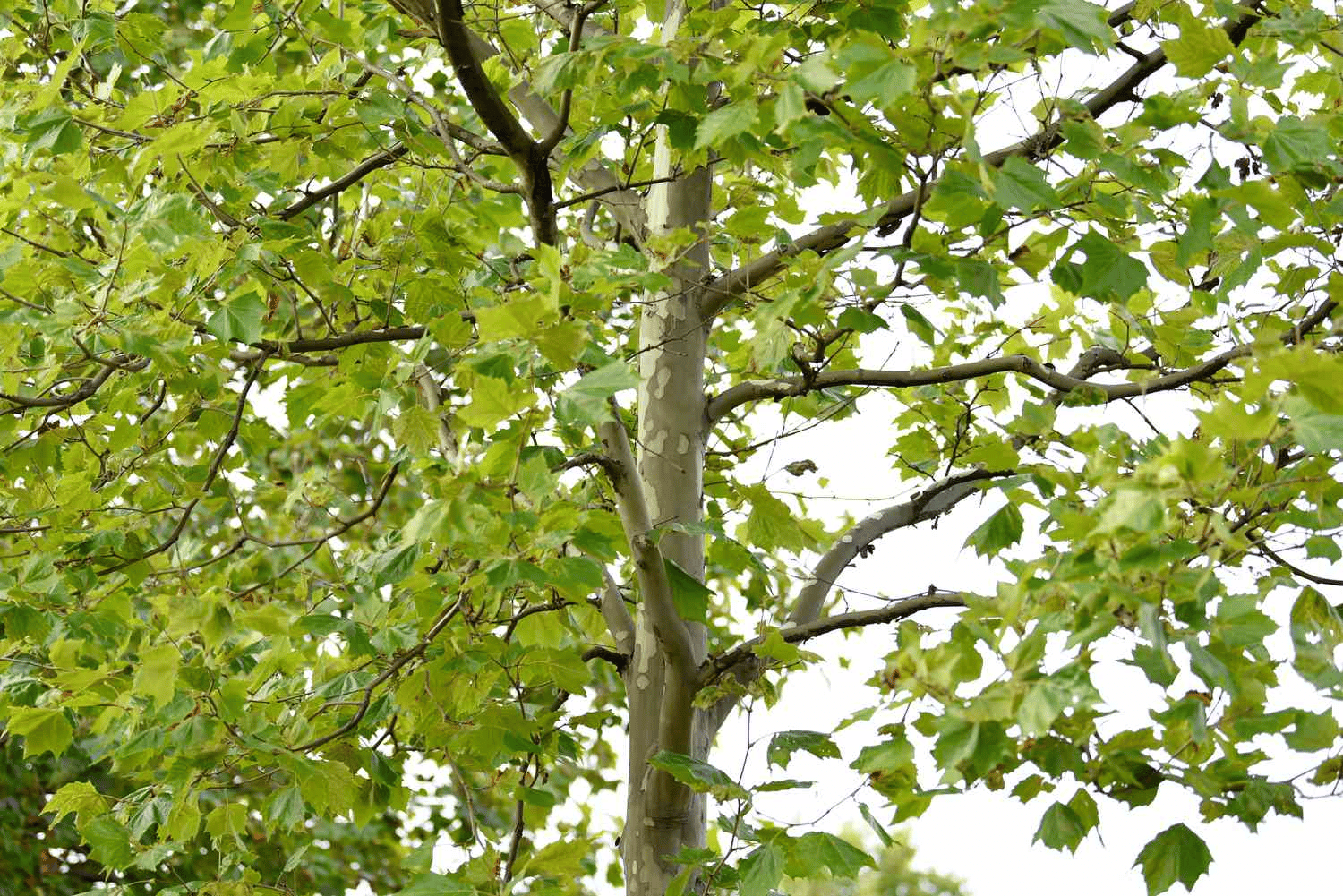
Sycamore
This Tennessee native is known as the largest growing tree in the east, and it provides plenty of shade as such. These giants can grow over 70 feet tall and several feet in diameter, so be sure you have plenty of room before planting one. Sycamores are also known for their scaly, grayish bark that reveals a smooth, white underlayer. Their branches yield large, green leaves that turn a yellow-brown color in autumn, hence why they’re exceptional shade trees. Sycamores are hardy and can endure pollution and extreme weather conditions, so they’d fare well and make quite the statement in any yard large enough to house them.

Serviceberry
Known by many names – juneberry, sugarplum, shadbush, etc. – the serviceberry is a large shrub or small tree loved by many, especially the birds. This plant produces fragrant, white flowers in early spring that make way for the berries wildlife enjoy so much. Their berries start small, round and green, but eventually turn red and then purplish-black as they ripen in summer. The serviceberry’s leaves appear in spring as a regular green color, but will turn yellow, orange or red in the fall. The plant averages 15-25 feet tall, depending on how it’s pruned. These plants also tolerate pollution well, so they fare well in urban settings like Nashville.
Autumn is an ideal time to plant trees, especially since the middle Tennessee weather tends to be on the warmer (and often more unpredictable) side. Don’t believe me? Check out our post on five reasons why fall is the best season for planting! Be sure to plant your trees with plenty of time for them to establish roots before winter sets in, so you can ensure your landscaping will look its best once spring comes around.
Have more questions, or need help finding the perfect tree for your yard? Give us a call, or visit our garden center in Nashville!











































 Eastern White Pine
Eastern White Pine



Recent Comments